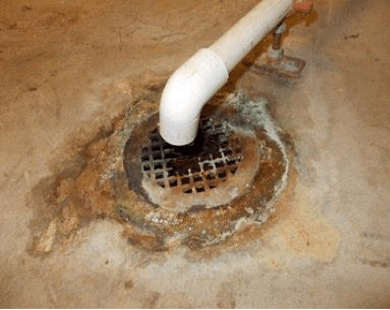The business development, training and implementation organization for the service business industry will offer its members access to the home service distributor’s extensive supply chain of products and solutions CEO Warrior, a nationally recognized business development, training and implementation organization for the service business industry, announced today that it has entered into a collaboration with Ferguson Read more
appliances

The business development, training and implementation organization for the service business industry will offer its members access to the home service distributor’s extensive supply chain of products and solutions
CEO Warrior, a nationally recognized business development, training and implementation organization for the service business industry, announced today that it has entered into a collaboration with Ferguson , a project success company providing expertise, solutions and products from infrastructure, plumbing and appliances to HVAC, fire, fabrication and more, to provide its members with preferred access to the home service fulfillment giant.

“This collaboration with Ferguson shows CEO Warrior’s commitment to add value to the services we provide our members,” CEO Warrior CEO Scott Bohannon said. “It is our goal to offer our clients everything they need to be successful in their markets. Not only does CEO Warrior offer a full complement of training and mentoring solutions that help our members lead, grow and scale their services, we can now also offer them access to some of the finest products available in Ferguson’s supply chain.”
Founded in 1953, Ferguson is a leading value-added distributor of residential and commercial plumbing supplies and pipe, valves and fittings in the U.S. The company has 10 distribution centers offering clients rapid inventory access with the convenience of Pro Pick-Up services in as little as one hour, same-day or next-day delivery options.
“I am incredibly excited about the relationship between CEO Warrior LLC and Ferguson,” said CEO Warrior Director of Business Development Caroline Moriarty. “This collaboration enables us to deliver greater value to our clients and reinforces our commitment to continued growth and high standards of quality products and services.”
CEO Warrior is the highest level business training and implementation organization in the trades industry. It is led by experts who have achieved success building and leading their own trades businesses and its members include the leaders of home service companies that provide plumbing, HVAC and other residential and commercial service companies.
For more information about CEO Warrior and how to become a member, please visit https://ceowarrior.com/.
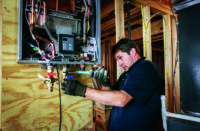
Hydronic heating offers complete, energy-saving system for homeowners When your customers are selecting home appliances, what priorities often drive their decision making? If the answer is cost, comfort, or environmental impact, they may be interested to learn more about hydronic systems, which offer efficient home and hot water heating simultaneously. When it comes to hydronic Read more
Hydronic heating offers complete, energy-saving system for homeowners
When your customers are selecting home appliances, what priorities often drive their decision making? If the answer is cost, comfort, or environmental impact, they may be interested to learn more about hydronic systems, which offer efficient home and hot water heating simultaneously.
When it comes to hydronic heating, there are different options: the hydronic furnace and in-floor hydronic radiant heat, which is most commonly used for homes in cold climates.
Here’s an overview of how one of these systems works and how they can benefit both you and your customers.
What is a hydronic furnace?
Hydronic furnaces connect seamlessly to select tankless water heaters and condensing boilers to deliver efficient, simultaneous home heating and domestic hot water in one complete system. Hydronic furnaces use hot water from a tankless water heater, saving installation costs—and making traditional furnaces seem like a thing of the past. By pairing them with propane-powered water heater, contractors can help their customers enjoy steady, comfortable heat throughout their home.
A propane-powered tankless water heater supplies continuous hot water—unlike a traditional storage tank with a capacity of just 50 or 75 gallons and required time to recover between uses—so the system can pump a constant flow through the heating coil and deliver steady, comfortable heat to the home without the need for a fuel-powered furnace, gas piping or an extra exhaust vent to the atmosphere. At the same time, the tankless water heater performs its primary job without interruption, prioritizing heating the water that is piped to showers, sinks, dishwashers, and washing machines.
These systems can be installed in a new home or added to an existing home and can be paired with an air-source heat pump to maintain comfort and efficiencies—even on cold days when the heat pump can’t keep up. Plus, this does away with the super in-efficient resistant heat coil for the emergency heat mode.
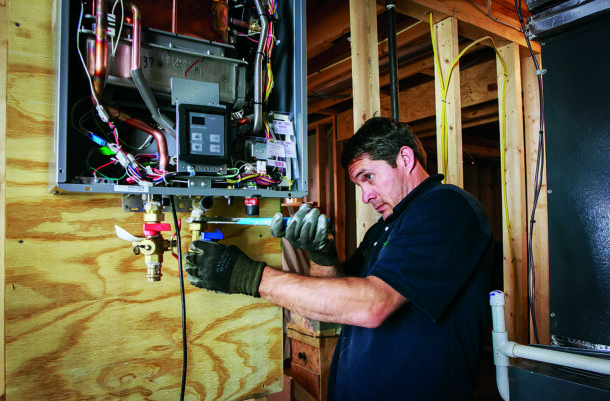
How can this technology benefit my customers?
With a hydronic furnace, homeowners can rely on steady, comfortable heating throughout their home, saving space, energy, and money.
Budget-friendly
A tankless water heater is typically more expensive than a traditional storage tank model, but some manufacturers offer the hydronic air handler for less than a comparable gas-powered condensing furnace. When you combine that with installation savings you end up with a lower cost installed product. Plus, because propane-powered tankless water heaters only heat water when it’s needed, they can help homeowners save more than $150 per year in energy costs when compared with typical electric storage tank water heaters.
Increased comfort and control
Comfort is one of the biggest perks of hydronic heating. In fact, many homeowners report that their heat is less dry than heat radiated via a traditional furnace. With a hydronic furnace, homeowners control the air temperature by setting a thermostat, just as they would with a traditional furnace or heat pump.
Sustainable operation
And for environmentally conscious homeowner customers, they can have peace of mind knowing their system is reducing emissions compared with other energy options. Notably, a propane tankless water heater produces roughly half of the carbon emissions of an electric storage tank system when full lifecycle emissions are taken into consideration. Plus, they’re aiding in water conservation efforts because hydronic systems create no wastewater. Instead, they take the water used to heat the air and recirculate it through the tankless water heater.
How can installing hydronic heating benefit my business?
The benefits of hydronic heating don’t stop with the customer. Plumbing and HVAC contractors can reap the benefits, too. The dual technology presents an opportunity for some plumbers to get into the heating business and some mechanical contractors to add tankless water heater installation to their line of services.
Some industry pros predict that builders will embrace hydronic heating as homebuyers already familiar with the benefits of energy- efficient tankless water heaters learn that those energy- and water-saving devices can also help heat their homes.
Visit Propane.com/Water-Heating to learn more.
 Bryan Cordill is director of residential and commercial business development for the Propane Education & Research Council. He can be reached at bryan.cordill@propane.com.
Bryan Cordill is director of residential and commercial business development for the Propane Education & Research Council. He can be reached at bryan.cordill@propane.com.
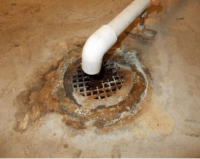
Most new residential and commercial heating and hot water systems include a furnace, boiler or domestic water heater of the high efficiency condensing type. Condensing appliances extract additional BTUs from the water vapor in the flue gas. When the flue gas drops below its dew point of approximately 135 degrees Fahrenheit, it starts to condense Read more
Most new residential and commercial heating and hot water systems include a furnace, boiler or domestic water heater of the high efficiency condensing type. Condensing appliances extract additional BTUs from the water vapor in the flue gas. When the flue gas drops below its dew point of approximately 135 degrees Fahrenheit, it starts to condense and the resulting liquid is acidic and requires treatment to avoid damage to piping systems, sewerage systems, treatment facilities, septic systems and other items it may come in contact with.
A general rule of thumb, one gallon of condensate is produced for every 100,000 BTUs of input providing the appliance is operating in full condensing mode. If an appliance having 100,000 BTUs of input operates for 1200 hours annually, it will produce approximately 1200 gallons of condensate.
The acidic level of the condensate is measured as its pH. Most condensate from natural gas appliances will have a pH of between 2.9 and 4 with 7 being neutral. The actual pH will vary according to the actual chemical makeup of the fuel that is being burned. Condensate contains different types of acids that are corrosive to many materials. The products of natural gas combustion generally include nitrogen oxides, sulfur oxides and hydrogen chloride, as well as water vapor and carbon dioxide. Hydrogen chloride is a result of the combustion of chlorides. These chlorides (salts) are contained in the combustion air.
Taking combustion air from outside generally reduces the amount of chlorides. Nitrogen oxides are a normal by product of combustion. Sulfur compounds are added to the natural gas in small amounts as an odorant.
Condensation of flue gas produces an acidic solution containing concentrations of nitric, nitrous, sulfuric, and sulfurous and hydrochloric acids. These acids can become more concentrated by repeated condensing and evaporation on heat exchangers and flues. Some say condensate from natural gas appliances is no more acidic than vinegar, urine and some citrus juices. Although the pH may be similar, it is a different type of acid and you can be certain no one is dumping thousands of gallons of these liquids into their drains.
A pH of 4 can damage drainage pipes, septic tanks, treatment plants and other materials handling waste water. The pH scale is not linear. Each whole number step below 7 is 10 times more acidic than the next higher number.
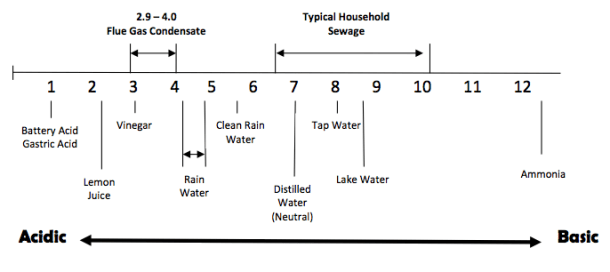
Update:
Treated condensate should be as close to neutral as possible with 5 being the minimum. Most national and state codes [1] prohibit anyone from allowing acidic liquid into a drainage system without treating it to raise its pH.
Treatment of this condensate is accomplished by exposing the liquid to a media containing different materials. We prefer a high quality calcite in combination with magnesium oxide. This blend takes advantage of the self-regulating calcite while adding in some fast acting magnesium oxide.
The acid is converted to water, carbon dioxide and mineral salts when exposed to the media. The carbon dioxide will generally stay diluted in the water and pass out of the neutralizer. The mineral salts generally settle at the bottom of the neutralizer. Over time the media dissolves and must be replenished.
How do you know if the neutralizer is working? Manufacturers of condensate neutralizers provide sizing guide lines and recommended maintenance (media replacement) intervals. The application should be monitored and checked periodically for optimal results. Sizing and maintenance intervals should be adjusted accordingly.
It is the responsibility of the plumbing professional to follow state and local plumbing codes including proper disposal of condensate and equally important for the end user to provide ongoing maintenance ensuring proper function of the unit. An example of damage caused by improperly treated condensate can be seen in the picture at the beginning of this paper. Damage can occur underground and in unseen, remote locations. Imagine digging up your basement floor to replace a rotted out metallic drain line!
[1] National Standard Plumbing Code Chapter 6; Massachusetts Plumbing Code CMR248 Chapter 10. IPC code 803.2
Mike Bernasconi is VP and co-owner of Neutrasafe Corporation, a Massachusetts based manufacturer of condensate neutralizers. Bernasconi, a licensed Master Plumber and hydronics specialist, has been working in the HVAC industry for 35+ years and is well known in the industry for hydronics design and execution. With the onset of condensing boilers, furnaces and hot water heaters, the installation of a condensate neutralizer is now a mandatory requirement. Bernasconi designed a condensate neutralizer with the installer in mind. His product contains a clear body, clean, consistent sized high quality media and offers ease of servicing. Neutrasafe Corporation partners with manufacturer representatives throughout the U.S. to distribute its products. Products can be viewed at www.neutrasafe.com. He can be reached at mike@neutrasafe.com


